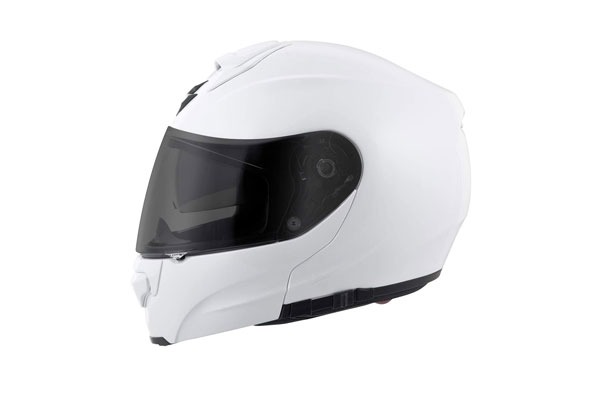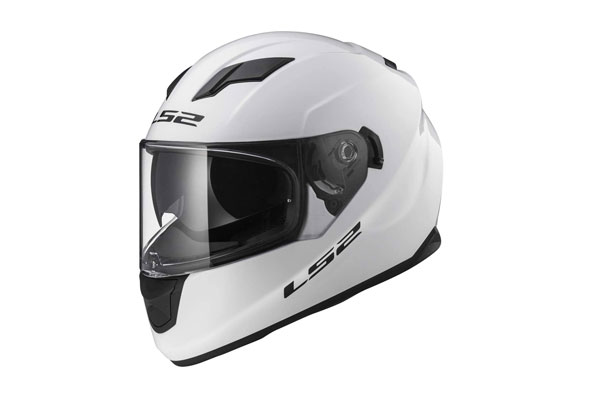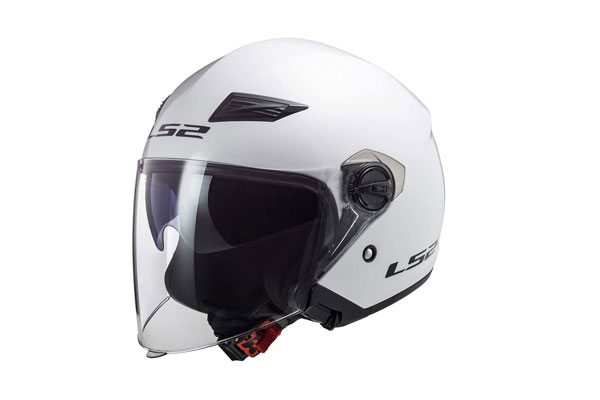For a biker, wearing a helmet can often turn out to be the dividing line between a severe accident and a close one. However, they can get rather tricky to fit if you also wear spectacles, as those designs aren’t suitable for your purposes. Therefore, instead of trying to get one of those on your glass-laden face, you need to find the best motorcycle helmet for glasses.
Here, we’ll be helping you with the best possible options, how they fare, and which one you should opt for.

Can You Wear Glasses While Wearing a Motorcycle Helmet?
Wearing a motorcycle helmet with the typically-designed options is far from ideal. Not only can it be uncomfortable, but it can also get in your way when you’re trying to concentrate on riding your bike, which is the last thing we want.
Fortunately, you can wear glasses while wearing a motorcycle helmet – you only need to buy one designed for this specific purpose. These products will provide the necessary space for your spectacles so that you can comfortably wear both.
Best Motorcycle Helmets for Glasses Wearers to Go
Finding the best motorcycle helmet for glasses wearers can be daunting if you wear glasses. So, here are our top picks to help you with finding the right one without doing guess works:
1. Bell Qualifier Full-Face Motorcycle Helmet for Glasses Wearers
One of the complaints that many riders have with their helmets is the weight. As you need to wear these for an extended period, it can get somewhat tiring at one point. That’s something our first pick is excellent at preventing.
Here, we have the Qualifier from Bell, a renowned name in the world of motorcycle gear. Upon wearing it, you will be surprised by how lightweight it is – so much so that it can even compete against carbon fiber products.
That’s possible due to the light polycarbonate/ABS shell that it uses. Another crucial factor is the wind noise that can affect your experience while riding fast. This helmet comes with a padded wind collar to reduce that noise.
But don’t worry about losing your hearing ability, as it won’t obstruct you from listening to the traffic noises. Another crucial bit is the large size of this helmet, making it suitable for wearing over glasses so that you can even adjust things while wearing it.
Not only that, but the visor also doesn’t have any tint by default, making it well-suited for you to wear it with your spectacles. Now, let’s move on to the protective features – namely the scratch resistance, UV protection, and so on.
It uses the NutraFog II system, which prevents your visor from fogging – allowing for a clear vision all the time. Furthermore, it comes with an anti-scratch and UV-protected shield that supports the ClickRelease method for effortless replacement.
Moreover, it’s DOT approved, which means wearing glasses with motorcycle helmet of this kind is peace of mind, knowing that you’re safe. Not only that, but it also meets the FMVSS 218 and CARB standards, making it an excellent choice for everyone.
Pros
- The visor prevents fogging
- Click Release for quick shield replacement
- Meets the FMVSS 218 Standard
- Velocity Flow ventilation system
- Padded wind collar to reduce noise
Cons
- Getting a tinted visor would cost extra
- A bit too tight for some
2. LS2 Full Face Stream Street Helmet
Generally, you will have to go with a large size if you want your helmet to have sufficient space for your glasses. Therefore, our next pick is an XX-Large helmet from LS2, which provides plenty of real estate for your spectacles.
Not only that, but you can also find a detailed guide from the manufacturer to find the right size for your head, depending on the measurements. So, let’s move on to the build quality now, starting with the polycarbonate outer layer.
As you probably know, polycarbonate is a popular material regarding the outer layer of a helmet. It is lightweight, and it provides you decent protection against any impact to protect the interior and your head.
Another crucial factor for these products is whether they are DOT approved or not. A helmet needs to go through rigorous testing to prove that it can withstand substantial impacts without harming the user to conform to this standard.
As expected, this helmet gets that approval seal along with the FMVSS 218 Standard. Those two certifications in conjunction mean that this product is one of the safest options that you can opt for.
In terms of the fit, this helmet is long oval, which should be suitable for most users. But you should still make sure of that. It also comes with the Twin Shield inbuilt drop-down sun shield to protect your eyes, because it’s helmets for eyeglasses, which you can toggle with a touch.
Moreover, the quick-release chin strap is what makes it even more suitable for wearing it over glasses. And given that you can effortlessly remove and wash the fabric liner, you cannot go wrong with this helmet.
Pros
- An inbuilt drop-down sun shield system
- DOT-approved quick-release chin strap
- Long-oval sizing fits most
- You can remove and wash the liner
- HPTT polycarbonate alloy
Cons
- The neck collar’s quality needs improvement
- The visor occasionally makes a noise
3. GDM DK-120 Full Face Motorcycle Helmet
Many products on the market will come with either a clear visor or a tinted one. You might even need to pay extra for the latter in many cases, which is a bummer. Our third pick is unique in those terms, as it comes with both.
Here, we have a full-face motorcycle helmet from GDM. And as we said, it comes with two visors so that you can swap it out, depending on what you want. And that is especially impressive when you consider its price.
This helmet comes at a reasonable price tag, given the quality material and build quality. For one, its outer shell features an aerodynamic design made with a surprisingly lightweight composite poly-alloy, which allows you to wear it for a long time.
Another crucial feature that many products miss out on is a removable liner that you can clean. Otherwise, it can have a build-up of dirt and moisture in a way that would be far from being pleasant.
Fortunately, you can take the comfort liner and cheek pads off and wash them with ease on this helmet, which we appreciate. And another unique property is that it is Bluetooth compatible – an excellent feature for the price.
As you’d expect from a product of such quality, this one is both DOT and FMVSS 218 certified, meaning you can be free of worries regarding its capabilities. Furthermore, it comes with a double D-ring chin strap for better accessibility.
This helmet also has a five-point ventilation system to allow you to wear it for a long time without feeling exhausted. Lastly, the optically correct and side-coverless face shield makes it an excellent choice for glass wearers.
Pros
- Inbuilt Bluetooth compatibility
- Scratch-resistant lightweight poly-alloy shell
- Optically-correct side coverless face shield
- Click Release system for quick shield swapping
- Five points of ventilation
Cons
- The ventilation could be better
- Visor attachment isn’t wholly secure
4. LS2 Open Face Track Helmet
At this point, we have got a helmet that’s different from the ones that we’ve reviewed so far – an open-face one. As you might know, these products have your face exposed, getting rid of the chin bar that full-face options have.
Such products are well-suited for people who find full-face helmets somewhat claustrophobic due to their design. This one is yet another product from LS2, which does an exceptional job ensuring a quality build with impressive experience.
This ¾ design also ensures a wide field of visibility, allowing your peripheral vision to work properly. However, there is one issue that these helmets cannot alleviate – a comparatively lower amount of protection for your face.
You see, the lack of a chin bar means that it won’t protect your face in case of an accident. Therefore, it would help if you kept this in mind. Other than that, this helmet performs exceptionally well – especially the built-in twin shield system.
It comes with a dual-layer shield that protects you from not only the sun but also the wind. That’s possible due to the varying sizes of the shields. Moreover, toggling them on or off only necessitates the slide of a switch.
In terms of the build quality, this product features a quality outer shell made with ABS, providing solid protection for the interior. The High-Pressure Thermoplastic Technology (AKA HPTT) used for this layer meets all the DOT and ECE standards.
And what good is a helmet without proper ventilation? Hence, it features a flow-through ventilation system. This mechanism allows for granular control over how you want the experience to be. That makes it one of the top motorcycle helmets for glasses.
Pros
- A wide field of visibility
- Built-in twin-shield system sun shield
- Switching the shield is effortless
- It exceeds both DOT and ECE standards
- No claustrophobic feeling
Cons
- Not as safe as full-face helmets
- The sizing is on the smaller side
5. ScorpionExo Full Face Modular Helmet

Now, the products above perform exceptionally well for their price, but you can only get so much with a budget constraint. Therefore, if you want to go for a premium product with all the bells and whistles.
Unlike the products above, this one is a unique variant of full-face helmets – a modular one. Do You know how full-face ones can feel somewhat trapped in, and open-face ones cannot achieve the same level of protection?
Well, this is the middle ground that provides you with the best of both worlds. For one, it’s essentially a full-face helmet, meaning it comes with a chin bar. However, you can also push that (and the visor) up whenever you want.
That ability allows you to turn it into an open-face helmet, which is nothing short of amazing. Another impressive bit about this product is the materials and build quality. For example, it uses composite fiberglass for the outer shell.
It uses Thermodynamic Composite Technology (TCT) to achieve the layer, making the otherwise brittle fiberglass extremely rigid with a core. This quality means that it will protect your head and the helmet’s interior with impressive integrity.
Another bit that we love about this product is the lining that it comes with. You get the Kwikwick III moisture-wicking liner along with washable 3D contoured cheek pads to provide you with the best possible fit and protection.
This DOT and FMVSS 218-certified helmet also comes with an aero-tuned ventilation system, which allows for a comfortable experience. Lastly, the Everclear no-fog drop-down visor makes it the best motorcycle helmet for glasses wearers.
Pros
- TCT-ultra lightweight system
- Aero-tuned ventilation mechanism
- Contoured cheek pads
- Washable moisture-wicking comfort liner
- Exceptional modular build
Cons
- A bit on the pricier side
- Its sizing can be tricky to get right
What to Look for Before Buying?
We can divide the process into two categories. The first one would be the criteria that apply to any motorcycle helmet, and the second one being specific feature sets for users that wear glasses. This guide should help you understand both and make a solid decision.
Design
The most crucial distinction among helmet designs would be the way it covers your face. There are two main categories here – open-face and full-face helmets. We’ll discuss their properties right now, and afterward, we’ll show you a comparison.
- Full-Face Helmets
As you can imagine from the name, a full-face helmet will cover your entire head (including your face, of course). Such products will protect your head and a part of your neck to ensure the highest protection level.
One of the unique features of such helmets is the chin bar, which goes below your jaw and chin. Another impressive bit about these products is that they can have inbuilt features to reduce visor fogging and wick moisture.
These can also come with tinted visors, which can render a sunglass useless. However, some people find that they feel somewhat trapped or claustrophobic while wearing a helmet like this.
- Open-Face Helmet
The naming convention with these products is pretty straightforward, thankfully. An open-face helmet will cover your head and neck but leave your face fully exposed. The most significant distinction would be the lack of a chin bar here.
Eyeglass friendly motorcycle helmet is pretty standard among people that prefer to have their faces left open. You might remember that some riders complain that the full-face options make them feel somewhat trapped, so this is an alternative many of them opt for.
Such helmets also weigh less since they don’t require as much material in production. Moreover, these products may or may not come with a visor, so you have the option to choose here.
There are a few more types that you might find – namely modular, off-road, dual-sport, and so on. However, you can have them fit into the primary categories of full-face and open-face helmets. Hence, we won’t discuss them separately.
Protection and Comfort
The most vital purpose of a helmet is to protect you from dust and dirt or a dangerous accident.
- Shell’s Material
It would help if you first look at the shell material, meaning the helmet’s outer layer. This one is the first line of defence you get, so nothing would matter if this portion broke down.
Generally, the most common materials in this regard would be polycarbonate or ABS. Whichever one you choose, the material’s quality must be impressive so that it can protect the interior.
- Padding
All motorcycle helmets will come with some form of lining or padding beneath the shell, which is a crucial portion. The padding plays two critical roles – absorbing the impact and providing comfort.
Many manufacturers use synthetic cellular materials for the lining (e.g., expanded polystyrene (EPS) or expanded polypropylene (EPP)). These can have various densities with different pads, so you should ensure that your helmet does well in this regard.
Head Shape
This bit might not seem like a concern at first, but you should pay attention to your head’s shape if you want motorcycle helmets for people with glasses to provide you with the best fit. Generally, you’ll hear of three forms – longer oval, intermediate oval, or round oval.
Choosing an option depending on your head’s shape can ensure that it gives you a suitable fit, making the experience even better. If you can’t seem to figure it out, intermediate oval can be a safe bet for most.
We would also recommend that you try wearing the helmet for a while before buying if it’s possible. That can give you a general idea regarding whether it is the right option or not.
Open Face or Full Face – What Type Is Better for Wearing a Glass?
When it comes to glass wearers, the biggest issue with choosing the best full face helmet for galsses and their motorcycles is deciding whether they should settle for open-face or full-face. Let’s have a comparison between the two to show you the pros and cons of both.
- Open-Face
Although there are some variations with these helmets, they usually have something in common – an exposed face and the absence of a chin bar. The most significant advantage here is that you’d have the easiest time wearing your glasses.
Moreover, you’ll feel the air on your face, which makes some people feel less trapped. However, that comes with disadvantages too. For one, these don’t provide as much protection for your chin, which often gets injured upon impact.
Furthermore, your typical pair of glasses probably won’t do enough to protect you from the wind and dirt when driving slightly faster. That would mean you might also need to get proper goggles for bike riding, and that’s a hassle and two.
- Closed-Face
The opposite of the previous section applies here. These helmets will come with chin bars, which will provide you with much better protection, which is essential. However, it can be comparatively harder to wear glasses with some of these.
But you can get push the visor up, which makes things easier. Furthermore, modular helmets allow you to push the chin bar upward as well. And you can pull the visor down once you’ve got your glasses on or are driving faster.
Therefore, we think that you should opt for a closed-face helmet for the highest level of protection along with the ability to wear glasses. And if you can get one, a modular product can make things even more effortless.
Frequently Asked Questions
Which motorcycle helmet provides the best protection?
The answer to that would be full-face helmets, without a doubt. These products protect your head, face, and neck. Furthermore, they come with chin bars to protect you in the case of an unfortunate incident, which open-face helmets cannot.
What motorcycle helmet will allow me to wear glasses?
Your helmet needs to provide a way for you to put on your glasses while wearing it and cause no obstructions while riding. Open-face and modular motorcycle helmets are exceptionally well-suited to allow you to wear your spectacles.
How often should I replace my helmet?
Although it might seem like it’s okay to wear your helmet for years if it didn’t face any accidents, the reality is different. The helmet, especially its inner linings, will slowly degrade over time. Hence, you should replace your motorcycle helmet every three to five years.
Will a motorcycle helmet obstruct my field of vision?
If you have switched to a full-face helmet, you might feel like it’s affecting your peripheral vision. However, any decent helmet prevents that from happening, especially the DOT-compliant ones with at least 210-degree vision (our vision can extend around 180 degrees).
Do helmets prevent you from hearing traffic sounds?
Now, here’s yet another myth that claims you’ll lose much of your hearing ability when wearing a helmet. However, that’s not the truth. It’s quite the contrary – as the helmet can help cut down on the sound of wind and has air vents, it can help you hear better.
Final Words
Wearing the glasses-friendly motorcycle helmets is somewhat tricky if you don’t have the right helmet. And getting the right helmet depends on a few factors which we’ve considered while compiling the list above. You can get the best motorcycle helmets for glasses wearers from our list without any hesitation.
However, if you want an editorial suggestion from an expert’s perspective, getting the Bell Qualifier helmet would be the best option. Apart from having a perfect shape for using it with glasses on, it has a polycarbonate ABS heavy-duty shell construction for extra durability. Its NutraFog II front offers a UV-protected shield for extra glass protection and Velocity flow ventilation for long rides.
Jason, a helmet enthusiast, is the owner of HelmetsAdvisor.com shares his innovative idea that helps people get the proper knowledge of helmets and their accessories to go ahead!
Helmets are usually life-saving elements to run! That's why, an expert on helmets, Jason built this site to express his gathering knowledge and first-hand user experience over decades.




